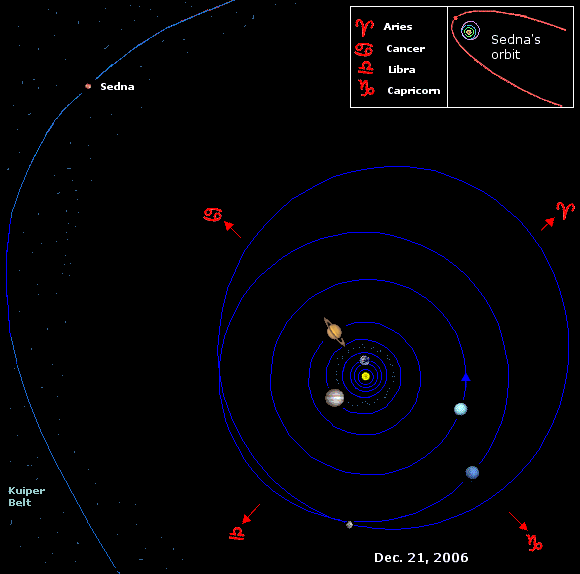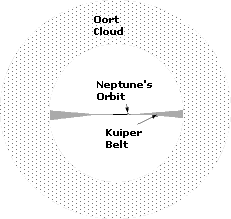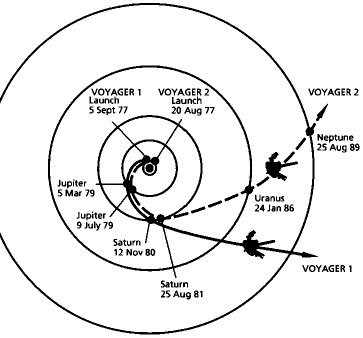 Science
Science
 Astronomy
Astronomy

Don's Home
 Science
Science
 Astronomy
Astronomy

| Contact |
 In 2006 Members of the International Astronomical Union decided Pluto should be stripped of its planet status and classified as a dwarf planet along with charon in the asteroid belt and UB313, Sedna was still not classified as of Aug., 2006. See the Planet Page for more information. The Solar System is made up of the sun, the planets (major, planetoid, dwarf planets, plutoid), asteroids and comets. In addition there are man made objects, the spacestation and satellites.
Solar system distances are usually given in terms of Astronomical Units (AU), the average distance from earth to sun = 92.96 Million (M) mi = 149.60 M km | ||||||||||||||||||||||||||||||||||||||||||||||||||||||||||||||||||||||||||||||||||||||||||||||||||||||||||||||||||||||||||
| 
| |||||||||||||||||||||||||||||||||||||||||||||||||||||||||||||||||||||||||||||||||||||||||||||||||||||||||||||||||||||||||
|
(Note: above distances are from edge to edge; distance from the sun is 1/2 that.)
Most of the planets orbit in the same plane called the eliptic plane. The plane of the planets is perpindicular to the plane of the gallaxy. All the planets rotate in the same direction as their orbits (counter clockwise when looking from the north) except Venus, and Uranus and Pluto. Venus rotates clockwise when viewed from the north the sun rises in the west. Uranus' and pluto's axis are almost parallel to the ecliptic (i.e. tilted 90°). None of the planets have a perfectly circular orbit (eccentricity = 0). Most have slightly oval orbits (eccentricity ranges from .007 - .09). The orbits of Mercury (.21), Pluto (.25) and Sedna (.84) are more oval (eccentricity > .20). See eccentricity below. A planet will be moving at its greatest speed at perihelion. At aphelion it will be moving at its slowest. The earth is moving at 68,893 MPH (30.80 km/s) at perihelion and 64,442 MPH at aphelion.
The Sun orbits around the center of the Milky Way Galaxy at a speed that is about 230 kilometers per second. This is in a frame centered on the Galaxy and which does not rotate. Most of the stars near the Sun have similar motions. The Galaxy itself is moving at several hundred kilometers per second with respect to a reference frame defined by the cosmic microwave background (radiation left over from the Big Bang).
Other bodies:
There are 26 known asteroids larger than 200 km in diameter. Chiron was discovered in 1977. It lies between Saturn and Uranus and occasionally passes within the orbit of Saturn. At first thought to be a comet or asteroid it is now considered a "planetoid" or small planet-like body. It is 170 km in diameter. Our Sun, with its family of planets, is racing around the center of our Galaxy (moving towards the constellation cignus, north of Capricorn) at about 250 km/sec (563,000 miles per hour). Even at that incredible speed, our solar system requires about 225 million years to complete just one revolution. 4.4 billion years ago: The Moon forms as a satellite of Earth
Constellations:
Astronomical and Astrological dates are when the sun enteres the constellation, so it cannot be seen in the night time sky then. Astrological Dates are for the Tropical zodiac there is also a Sidereal zodiac and the dates change by year. Serpens, The Serpent, and Ophiuchus, The Serpent Holder, originally formed one constellation. Serpens is now a two section constellation: Divided into head and body by the intervening Ophiuchus. They are crossed by the ecliptic but is not a zodiacal constellation.
Despite the fact that many diagrams represent the solar system as having each orbit the same distance apart, in actuality the orbits are largely arranged geometrically, that is, each is from 1 1/2 to 3 times the distance from the Sun as the one before it.
See:
Voyager: | ||||||||||||||||||||||||||||||||||||||||||||||||||||||||||||||||||||||||||||||||||||||||||||||||||||||||||||||||||||||||||

|    
| |||||||||||||||||||||||||||||||||||||||||||||||||||||||||||||||||||||||||||||||||||||||||||||||||||||||||||||||||||||||||
|
The Voyager mission was designed to take advantage of a rare geometric arrangement of the outer planets in the late 1970s and the 1980s which allowed for a four-planet tour for a minimum of propellant and trip time.
Voyager 1 is now leaving the solar system, rising above the ecliptic plane at an angle of about 35 degrees at a rate of about 520 million kilometers (about 320 million miles) a year. Voyager 2 is also headed out of the solar system, diving below the ecliptic plane at an angle of about 48 degrees and a rate of about 470 million kilometers (about 290 million miles) a year. Both spacecraft will continue to study ultraviolet sources among the stars, and the fields and particles instruments aboard the Voyagers will continue to search for the boundary between the Sun's influence and interstellar space. The Voyagers are expected to return valuable data for two or three more decades. Communications will be maintained until the Voyagers' nuclear power sources can no longer supply enough electrical energy to power critical subsystems.
Source: Voyager at NASA.
Eccentricity:
See Also: /TABLE> | ||||||||||||||||||||||||||||||||||||||||||||||||||||||||||||||||||||||||||||||||||||||||||||||||||||||||||||||||||||||||||